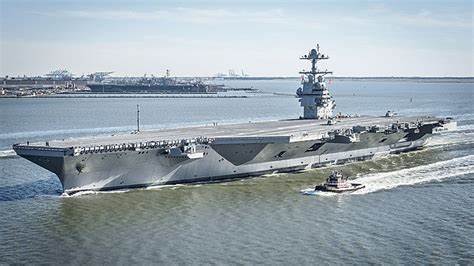
As the waves churn and the geopolitical tides shift, the eyes of military tech and politics enthusiasts remain steadfast on the U.S.

Navy’s Ford-class aircraft carriers, marvelously sophisticated and staggeringly costly symbols of American sea power.

At the heart of the debate are the titanic costs and strategic viability of these steel giants as they sail into an era of rapid anti-ship technology advancements.

The Ford-class carriers, an evolution of the Nimitz-class, have been wrought to assume dominion over the seas.

The USS Gerald R. Ford (CVN-78), a marvel of engineering, is the first of its kind, boasting improved Sortie Generation Rates and the revolutionary Electromagnetic Aircraft Launch System (EMALS).

But with a colossal price tag of $13 billion each and overall program costs ballooning to $120 billion, questions resound about the wisdom of such an investment.

which is $40 billion over budget, and expected to increase as future vessels are constructed, launched, and commissioned.

While some argue that these carriers are essential to projecting power across the globe—particularly in the face of potential conflicts with powers —others cast a skeptical eye.

Could the Ford-class carriers be sailing towards obsolescence, outflanked by cheaper and increasingly sophisticated drones and missiles?

This is the vexing conundrum that fuels discussions in defense circles and among the public, whose taxes swell the Navy’s coffers.

Indeed, the economic and strategic currents are as unpredictable as the seas these carriers traverse.

The USS Gerald R. Ford has completed an extended maiden deployment, a testament to its capabilities and readiness.

Yet, the waters are not entirely calm. The delay in the delivery of the future USS Enterprise (CVN-80) by 18 months and the postponement of the purchase of the next carriers, CVN-82 and CVN-83, signal the tremors affecting the program.

Supply chain snarls, material availability issues, and cost concerns are formidable waves this fleet must navigate.Navy officials stated that they expected to save $4 billion with the block buy.

Both service officials and HII executives confirm that the block buy is resulting in cost savings, and they are aiming for another one for CVN-82 and CVN-83. However, any future block buy will need approval from Congress.
Relevant articles:
– The U.S. Navy’s Ford-Class Aircraft Carriers: A $120 Billion Mistake?, The National Interest
– U.S. Navy Ford-Class Aircraft Carrier: A Waste of $120 Billion?, The National Interest
– Aircraft Carrier Enterprise Delivery Delayed by 18 Months, Says Navy, USNI News
– USS Gerald R. Ford Arrives Home From Maiden Deployment After 3 Extensions, USNI News

